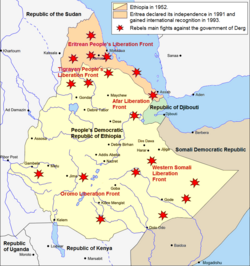
The Ethiopian Civil War was a war which affected Ethiopia in the Horn of Africa between 1974 and 1991. The war commenced owing to a wide range of political and socio-economic factors which led to the Ethiopian Revolution and the overthrow of Emperor Haile Selassie in 1974. Selassie’s fall was just the beginning of a wide-ranging and multi-factorial conflict, as religious and ethnic tensions between Muslims and Christians, and Oromo, Amhara, Tigrayans and Afars burst forth. This then became a front in the Cold War as the Derg Marxist-Leninist group seized power, fighting against many regional separatists. The crisis was punctuated by two major famines and a wave of atrocities, most notably the Red Terror committed by the Derg, leading to an estimated one and a half million deaths in all. The situation was further compounded by border wars with Somalia and the Eritrean secessionist movement. Millions of people were displaced. Many fled over Ethiopia’s borders, primarily into Kenya and Sudan, from which many were resettled in western countries in the 1990s, creating a considerable worldwide Ethiopian diaspora.[1]
Ethiopian Civil War chronology of eventsEthiopian Civil War chronology of events

The causes of the Ethiopian Civil War were multi-factorial. There was growing disillusionment at the reign of Emperor Haile Selassie, who had ruled what had earlier been known as Abyssinia since 1930 and before that as a regent since 1916. There were also growing winds of political change across Africa as new Marxist-Leninist movements emerged in many countries in the context of the Cold War. The most pressing issue, though, was the Wollo Famine of 1972 to 1975 in the north of the country. The response to it inflamed ethnic and religious tensions in a country where, broadly speaking, two-thirds of people were Christian and one-third were Muslim, and where different groups such as the Oromo, Amhara, Tigrayans, Somalis and Afars predominated in distinct parts of the country.[2]
These tensions boiled over in January 1974 as parts of the Ethiopian military revolted in the first acts of the Ethiopian Revolution. By the summer of that year these had begun to coalesce into clear movements, with the Derg, meaning ‘council’, emerging as a Marxist-Leninist group in opposition to the imperial government. They overthrew Haile Selassie in September of that year and formed a new government. However, as is so often the case with modern revolutions, there were many competing entities in the country that were unhappy with the new direction and began seizing power in individual cities and provinces. Thus, the Ethiopian Revolution quickly gave way to the Ethiopian Civil War.[3]
This was a complex conflict with many different entities. One of the biggest opponents of the government was the Tigray People’s Liberation Front, formed early in 1975 to fight for the cause of the Tigrayan people that dominate parts of northern Ethiopia. Other groups were soon formed to represent the interests of the Oromo and Amhara people, the two largest ethnic denominations in Ethiopia, while in the east of the country, the Western Somali Liberation Front was formed. There were additional separatist movements in Eritrea and Ogaden, which further complicated matters. Such was the number of opposition movements involved that the Derg might have been defeated quite quickly had they not been supported by the Soviet Union as the Horn of Africa became a new front in the Cold War.[4]
Fighting raged for seventeen years between the different parties. It was particularly intense in the late 1970s. A large government campaign to try and crush the insurrectionist movements was undertaken in 1982. This contributed partially to the development of the worst famine that the Horn of Africa had seen in a century between 1983 and 1985, though it was also brought about by a major drought which afflicted the region in the mid-1980s.[5] The war finally began to wind down in the early 1990s as the collapse of the Soviet Union and the end of the Cold War left the Derg isolated just as wider geopolitical events in neighboring Somalia and other countries were changing the dynamics of the conflict. The Derg was overthrown by a coalition of Tigrayan, Oromo and Amhara groups banded together as the Ethiopian People’s Revolutionary Democratic Front in 1991.[6] This ostensibly brought the war to an end, though war with Eritrea continued through the 1990s and Ethiopia has become destabilized in recent years, leading to the Tigray War between 2020 and 2022.[7]
Extent of migration caused by the Ethiopian Civil WarExtent of migration caused by the Ethiopian Civil War

Millions of people were displaced internally within Ethiopia as a result of the civil war. There were also periods in which many people began leaving the country altogether. Tensions and outright clashes with Eritrea and Somalia largely blocked access to either the Red Sea or the Indian Ocean and the majority of those who fled Ethiopia did so over the land borders to what was then a unified Sudan and to Kenya. The most intense period of migration occurred in the mid-1980s at the height of the famine. Any figures for this exodus are far from precise, but most studies agree that over half a million Ethiopians fled the country during this particular phase of the crisis.[8]
Demographic impact of the Ethiopian Civil WarDemographic impact of the Ethiopian Civil War
The Ethiopian Civil War led to an estimated 1.5 million deaths, mostly from famine, but also from the fighting and a wide range of civilian atrocities committed by multiple parties in the war. Other estimates place the death toll higher towards two million. This, combined with the flight of hundreds of thousands of people over the borders to Sudan and Kenya, limited population growth in Ethiopia, a country of just over thirty million people at the time of the commencement of the Ethiopian Revolution. It did not lead to any population decline though. On the contrary, by the time the many conflicts came to an end in the early 1990s, Ethiopia’s population was nearing fifty million people and it has exploded upwards since to over 125 million people.[9]
The outward migration seen during the war contributed towards the development of an internationally significant Ethiopian diaspora. Many of the people involved remained in Kenya or Sudan, though establishing the figures can be difficult, in part because many groups identify more along ethnic lines than national lines in the Horn of Africa. Hence, since the Oromo people are a major constituent group in both Ethiopia and Kenya, an Oromo family who moved from Ethiopia to Kenya in the 1980s need not necessarily identify as Ethiopians in Kenya, but simply as Oromo. Others moved on from Sudan and Kenya in the 1980s and 1990s and form part of Ethiopian diaspora communities further afield today. There are for instance, tens of thousands of Ethiopians in the United States whose roots in the country are found in the civil war period, while there are large Ethiopian communities tens of thousands strong as well in the United Kingdom, Canada, Australia, South Africa, Sweden, Germany and Norway.[10]
Research Ethiopian ancestors in the United States on MyHeritageResearch Ethiopian ancestors in the United States on MyHeritage
Research your ancestors on MyHeritage
See alsoSee also
Explore more about the Ethiopian Civil WarExplore more about the Ethiopian Civil War
- The Derg at GlobalSecurity.org
- Ethiopia: Conflict and food insecurity 40 years on from the 1984 famine at the House of Lords Library
- Atrocities in Revolutionary Ethiopia, 1974-79: Towards a Comparative Analysis at Journal of Genocide Research
References
- ↑ Gebru Tareke, Donald Kagan and Frederick Kagan, The Ethiopian Revolution: War in the Horn of Africa (Yale, 2009).
- ↑ M. Z. Teshome, ‘Management of ethnic conflict in Ethiopia: The case of Amhara and Oromo ethnic groups’, in Journal of Law and Conflict Resolution, Vol. 12, No. 2 (2021), pp. 25-33.
- ↑ Tareke, Kagan and Kagan, The Ethiopian Revolution.
- ↑ Harry Brind, ‘Soviet Policy in the Horn of Africa’, in International Affairs, Vol. 60, No. 1 (Winter, 1983/4), pp. 75–95.
- ↑ https://lordslibrary.parliament.uk/ethiopia-conflict-and-food-insecurity-40-years-on-from-the-1984-famine/
- ↑ https://www.hrw.org/reports/1997/ethiopia/Ethio97d-02.htm
- ↑ https://www.cfr.org/global-conflict-tracker/conflict/conflict-ethiopia
- ↑ https://www.migrationpolicy.org/article/ethiopia-origin-refugees-transition
- ↑ https://worldpopulationreview.com/countries/ethiopia
- ↑ Solomon Getahun, ‘The Role of the Ethiopian Diaspora in Ethiopia’, in International Journal of Ethiopian Studies, Vol. 13, No. 2, Special Issue (2019), pp. 215–228.


